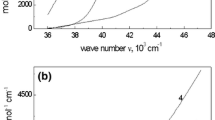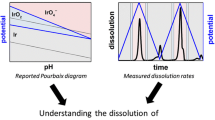Abstract
The dissolution of gold with elemental bromine was studied by using a rotating disc technique. The main parameters studied were bromine and bromide concentrations, stirring speed, pH, and temperature. The effect of various salts, manganese, and hydrogen peroxide was also examined. The dissolution kinetics of gold with Br2 and NaBr mixture is complex. The reaction mechanism is a function of solution composition, which determines the kind of adsorbing species. For an excess concentration of bromide ions, the rate expression is Rate = (2k cl7 k al6)1/2 K 15 [Br −3 ] and for an excess concentration of bromine, the rate expression is Rate = (2k c27 k a29)1/2 [Br−]1/2 {K25 [Br2]3/(1 +K 25 [Br2]3)}1/2
Gold in bromine solutions dissolves according to electrochemical/chemical (EC) mechanisms. The electrochemical component of the mechanism is responsible for the formation of AuBr2. In the chemical component of the mechanism, this monovalent gold bromide disproportionates into gold and stable AuBr −4 , which reports into solution. With respect to pH, there are two characteristic dissolution regions. In the pH range of 1 to 7, gold dissolution rates were insensitive to pH. Above pH 7, gold dissolution rates decreased with increase of pH.
Similar content being viewed by others
Abbreviations
- j:
-
flux, moles/cm2s
- A:
-
surface area, cm2
- R:
-
universal gas constant
- C:
-
concentration of lixiviant, moles/cm3
- D:
-
diffusion coefficient, cm2/s
- υ:
-
kinematic viscosity, cm2/s
- ω:
-
angular velocity, rad/s
- T:
-
temperature
- [Br−]:
-
bulk concentration of bromide ions
- [Br −3 ]:
-
bulk concentration of tribromide ions
- [Br2]:
-
bulk concentration of bromine
- [HOBr]:
-
bulk concentration of hypobromous acid
- [BrO−]:
-
bulk concentration of bromite ion
- Kd:
-
dissociation, hydrolysis, and complexation
- Kh:
-
equilibrium constants, respectively
- F:
-
Faraday’sconstant
- K:
-
equilibrium constant
- Em:
-
mixed potential
- kai, k′ai :
-
rate constants for the forward and reverse directions, respectively, of the anodic process given by Reaction [i]
- kci, k′ci :
-
rate constants for the forward and reverse directions, respectively, of the cathodic process given by Reaction [i]
- Za :
-
total number of electrons transferred in the anodic half-cell reaction
- θ:
-
fraction of total available surface sites occupied by adsorbed Br −3
- θc :
-
fraction of total available surface sites occupied by adsorbed Br2
- SCE:
-
standard calomel electrode
References
C.A. Shaeffer: United States Patent No. 267,723, 1882.
B.C. Hinman: United States Patent Nos. 545,890 and 545,891, 1895.
H.R. Cassel: United States Patent Nos. 732,706, 1903, and 732,709, 1903.
C.G. Fink and G.L. Putnam: United States Patent No. 2,283,198, 1942.
R.H. Sergent and K.N. Thanstrom: United States Patent No. 4,637,865, 1987.
R.H. Sergent:Randol Gold Forum 88, Scottsdale, AZ, Jan. 23–24, 1988, Randol International Ltd., Golden, CO.
A. Dadgar:Precious Metals ’s89, M.C. Jha, S.D. Hill, and M. El Guindy, eds., TMS, Warrendale, PA, 1989, pp. 227–40.
A. Dadgar:J. Met., 1989, December, pp. 37–41.
B. Pesic and R.H. Sergent:EPD Congress ’s90, D.R. Gaskell, ed., TMS, Warrendale, PA, 1990, pp. 355–91. 355–91.
B. Pesic and R.H. Sergent:J. Met., 1991, December, pp. 35–37.
G.I.Z. Kalocsai: United States Patent No. 4,684,404.
V.G. Levich:Physicochemical Hydrodynamics, Prentice Hall, Englewood Cliffs, NJ, 1962.
W.M. Latimer:The Oxidation States of the Elements and Their Potentials in Aqueous Solutions, Prentice Hall, Englewood Cliffs, NJ, 1952.
L. Farkas and M. Lewis:J. Am. Chem. Soc, 1950, vol. 72, pp. 5766–67.
H.A. Liebhafsky:J. Am. Chem. Soc, 1934, vol. 56, pp. 1500–05.
R.O. Griffith, A. McKeown, and A.G. Winn:Trans. Faraday Soc, 1932, vol. 28, pp. 101–07.
D.H. Evans and J.J. Lingane:J. Electroanal. Chem., 1963, vol. 6, pp. 1–10.
B.I. Peshchevitskii, V.P. Kazakov, and A.M. Erenburg:Zh. Neorg. Khim., 1963, vol. 8, pp. 853–59.
G. Milazzo and S. Caroli:Tables of Standard Electrode Potentials, John Wiley, New York, NY, 1978.
A.J. Bard, R. Parsons, and J. Jordan:Standard Potentials in Aqueous Solutions, Marcel Dekker, New York, NY, 1985.
K.J. Vetter:Electrochemical Kinetics, Academic Press, New York, NY, 1967.
G.P. Power and I.M. Ritchie:J. Chem. Educ., 1983, vol. 60 12, pp. 1022–26.
G.P. Power and I.M. Ritchie:Electrochim. Acta, 1981, vol. 26 (8), pp. 1073–78.
G.P. Power and I.M. Ritchie:Electrochim. Acta, 1982, vol. 27 (1), pp. 165–69.
Author information
Authors and Affiliations
Rights and permissions
About this article
Cite this article
Pesic, B., Sergent, R.H. Reaction mechanism of gold dissolution with bromine. Metall Trans B 24, 419–431 (1993). https://doi.org/10.1007/BF02666424
Received:
Published:
Issue Date:
DOI: https://doi.org/10.1007/BF02666424




